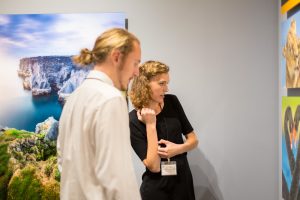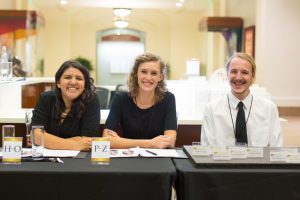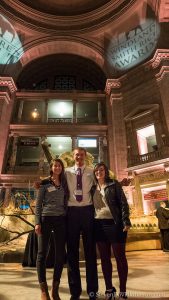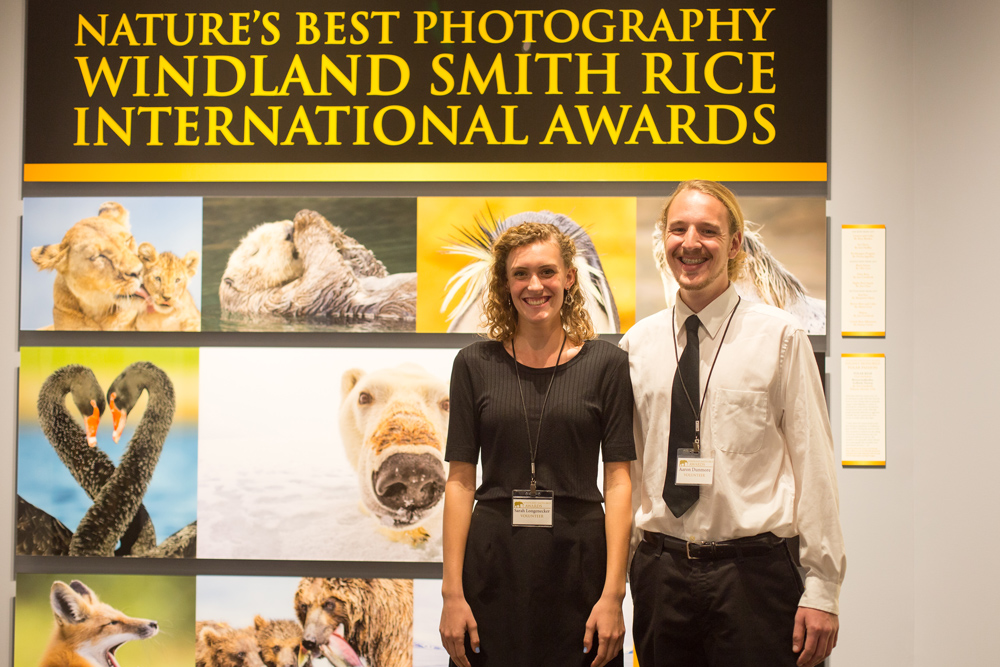Eastern Mennonite University photography students brushed shoulders this fall with some of the most acclaimed nature and conservation photographers in the world at the 21st annual Nature’s Best Photography Windland Smith Rice International Awards. Held at the Natural History Museum in Washington D.C., the evening gala hosts a dinner, awards ceremony and gallery opening for photographers with work selected from among 25,000 entries.
Diana Mendoza, Sarah Longenecker, Lauren Eckenroad and Aaron Dunmore greeted photographers and VIP sponsors, handed out name tags, and directed guests through various venues during the evening. With the exception of Dunmore, all are students in Professor Steven Johnson’s conservation photography class.
This is the third consecutive year that EMU students have volunteered at the event and garnered praise from organizers, Johnson says. “Event organizers are delighted when EMU students return year after year. It’s a chance for them to view some of the best work in an exciting field, and to gain knowledge, grow networking skills and learn about professional practices.”
Macson McGuigan, who volunteered at the 2015 event, recently received a North American Nature Photography Association (NANPA) scholarship to attend the 2017 Summit in Jacksonville, Florida. He is a double major in digital media and environmental sustainability. [View his work for Wild Virginia.]
“While there, he’ll work with professional mentors in the field and collaborate on a creative story project with other student scholars,” Johnson says. “The broadening experience of attending the Nature’s Best event helps our students gain important skills that can lead to opportunities like this.”
Meeting famous photographers

One of Longenecker’s favorite moments was greeting Clay Bolt, a colleague of Johnson’s who had Skyped into the class to talk about his work with World Wildlife Fund and National Geographic. Bolt, who is president of NANPA, specializes in photographing “the world’s smaller creatures,” according to his blog.
“It was exciting to introduce ourselves to him and meet him in person,” Longenecker said. She also met the creators of two favorite images in the exhibit, Cristobal Serrano from Spain, and Nico Perez , of Argentina.
Eckenroad’s highlight was meeting 23-year-old Canadian Jess Findlay, who won the Nature’s Best International Youth Photographer of the Year award in 2011. That win prompted him to pursue photography full-time, and he’s since won BBC Wildlife Photographer of the Year.
Coursework, equipment prepares students for profession
Interacting with photographers was a special experience, said Eckenroad, who plans on opening her own photography business after graduation. “It was amazing to see that hard work, dedication and lots and lots of time pays off. I walked away extremely inspired and more driven to improve at my craft.”

Though the event was attended by elite photographers who travel the world, Longenecker said viewing their work made the field seem more accessible and success “a little bit more attainable.”
“The event made me think the work we do in our class at EMU isn’t far removed from the world of professional conservation photography as it once had,” she said, adding that Johnson’s tutelage and professional experience have been invaluable.
Students are pushed to produce high quality work, she says, with the aid of Johnson’s expertise and with access to similar equipment used by these award-winning professional photographers.
“Under each photo in the exhibit there was a caption listing the equipment and settings used to create the image,” she said.”I was surprised to see that most of the equipment the photographers’ used was equipment that is available to us at EMU.”
Johnson began offering the conservation photography class in fall 2013 after spending a sabbatical year in the Pacific Northwest, where he and his wife, writer Anna Maria Johnson, joined creative forces on a photo essay project about the Cascade-Siskiyou National Monument and the need for conservation.
The course attracts mainly advanced photography students in EMU’s Visual and Communication Arts major but is open to interested students in other relevant majors such as environmental sustainability.
During field trips to the George Washington National Forest and other nearby wilderness locations, students practice skills and gain confidence in their arts-based advocacy. Photos taken by students have been used by area non-profits such as Friends of Shenandoah Mountain in advocacy efforts around the proposed Atlantic Coast Pipeline project.

Conservation photography, says Longenecker, is “about creating empathy and appreciation for the creatures living all around us and their habitats. Most people don’t get the opportunity to see the same things that conservation photographers see, so it’s important for photographers to share these unique experiences with other people visually so that they can understand and appreciate the natural world, even if they don’t get the chance to explore it firsthand.”
Sitting in the audience at the Nature’s Best Photography Awards, Longenecker wasn’t surprised to hear Photographer of the Year Daisy Gilardini share a similar message. Gilardini’s image of a polar bear and her cub, titled “Motherhood,” won the grand prize.
Gilardini “was thankful for the opportunity to be the voice of animals and ecosystems that can’t speak for themselves,” Longenecker said. “She kept emphasizing that the focus should not be on her, but rather on the animals she was representing. I was impressed with her dedication and passion for her work.”
